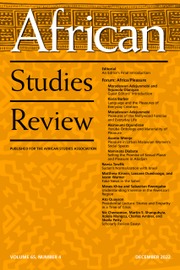Amanda Lock Swarr’s Envisioning African Intersex is a groundbreaking contribution not only to intersex studies, but to scholarship on the history of sex, race, and medicine. Among its central themes, the book scrutinizes the trope, uncritically repeated over centuries in medical texts and popular narratives, that intersex is disproportionately common among Black South Africans. Debunking this assertion and critically tracing how it has been repeated and amplified as historical truth alone makes Envisioning African Intersex an incisive and invaluable work of scholarship. But more broadly, the text deftly deconstructs the myriad ways that racial stereotypes and colonial legacies continue to shape the regulation of intersex and gender difference, with insights that are relevant to a variety of disciplines.
Envisioning African Intersex proceeds in two parts. Part One charts the emergence and reification of racialized notions of intersex prevalence. It focuses in particular on sensationalized depictions of the genital anatomies of Black South Africans, and the ways in which those depictions informed and were reinforced by medical literature into the late twentieth century and the present day. As the title of the book suggests, Swarr is particularly attentive to the ways in which photography has been used to advance racialized and gendered claims about bodily difference, and the violence that this particular medium of medical knowledge can visit on intersex bodies.
Envisioning African Intersex is powerful in part because it convincingly corrects a history with troubling implications, which has been inscribed and reinscribed through medical research and practice. But it is also forward-looking, with insights about the past, present, and future of intersex activism in South Africa that are deeply relevant to contemporary debates. Part Two of the book examines moves by intersex advocates to assert agency and press for social and political change, looking in turn at the pathbreaking scholarship and activism of Sally Gross, the ways in which Caster Semenya and other athletes have spoken back to contemporary gender policing in athletics, and new frontiers of intersex activism on social media and elsewhere.
In advancing these insights, Swarr is clear in her ethical and methodological commitments as well as her unsparing criticism of troubling medical and academic practice. As one example, the text describes and critiques specific photographic depictions of intersex persons in medical literature but Swarr opts not to reproduce those images for the reader, a deliberate choice made out of respect for the bodily autonomy of photographic subjects whose most intimate features have been routinely sensationalized and scrutinized. The choice is not only ethically defensible, but theoretically illuminating. The narrative descriptions of imagery allow Swarr to meaningfully foreground elements that might otherwise be overshadowed by the primary content of the photograph—for example, the way the photographs are framed, the hands manipulating and positioning a subject’s genitals, or the objectifying effects of strategies used to attempt to anonymize the photographs. Rather than treating these images and related medical research as fact, Swarr foregrounds what these sources of authority did and do, refocusing attention on the conditions of their production, their entrenchment in scholarship, and the public narratives they reinforced.
While Envisioning African Intersex promises to be a foundational text in critical intersex studies, it is also a methodological tour de force that seamlessly blends historical inquiry, ethnography, visual analysis, and decolonial, feminist, and queer theory. Swarr remarks at one point that long-standing questions about intersex depictions have led her to collect and reflect on primary materials for many years, and that persistent interest makes the breadth and depth of the resulting analysis formidable. The rigorous research and analysis that Swarr brings together in the text make her own conclusions compelling, but they are also highly likely to inform and enrich future intersex scholarship. In particular, Swarr does a great service to scholars of gender and sexuality by devoting a chapter to the work and theory of Sally Gross, a key figure in intersex activism in South Africa and internationally, and by vividly capturing the contemporary ephemera of social media posts, vlogs, reels, and digital campaigns that are driving a present-day moment of intersex imagination and activism. This attentiveness to both the legacies of colonialism in intersex medicine and the ways it is challenged and countered make Envisioning African Intersex a useful intervention not only for those who are particularly interested in intersex scholarship, but for scholars and students of history, medical anthropology, postcolonial studies, social movement studies, and media and visual studies as well.


